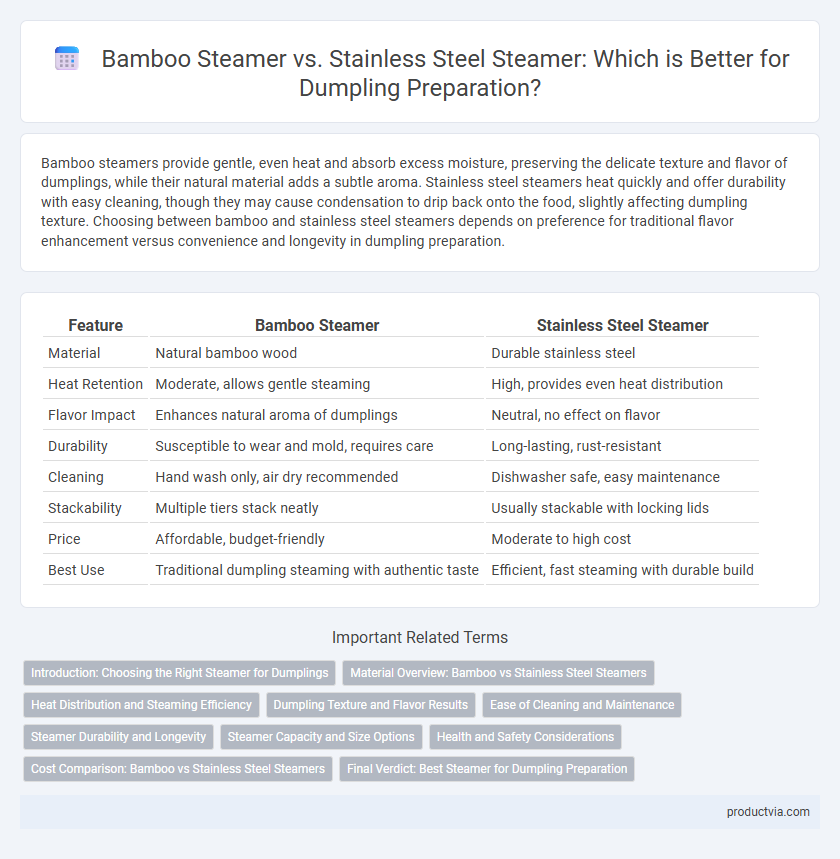Bamboo steamers provide gentle, even heat and absorb excess moisture, preserving the delicate texture and flavor of dumplings, while their natural material adds a subtle aroma. Stainless steel steamers heat quickly and offer durability with easy cleaning, though they may cause condensation to drip back onto the food, slightly affecting dumpling texture. Choosing between bamboo and stainless steel steamers depends on preference for traditional flavor enhancement versus convenience and longevity in dumpling preparation.
Table of Comparison
| Feature | Bamboo Steamer | Stainless Steel Steamer |
|---|---|---|
| Material | Natural bamboo wood | Durable stainless steel |
| Heat Retention | Moderate, allows gentle steaming | High, provides even heat distribution |
| Flavor Impact | Enhances natural aroma of dumplings | Neutral, no effect on flavor |
| Durability | Susceptible to wear and mold, requires care | Long-lasting, rust-resistant |
| Cleaning | Hand wash only, air dry recommended | Dishwasher safe, easy maintenance |
| Stackability | Multiple tiers stack neatly | Usually stackable with locking lids |
| Price | Affordable, budget-friendly | Moderate to high cost |
| Best Use | Traditional dumpling steaming with authentic taste | Efficient, fast steaming with durable build |
Introduction: Choosing the Right Steamer for Dumplings
Bamboo steamers provide gentle, even heat with natural moisture absorption, preserving the delicate texture of dumplings and imparting a subtle, earthy aroma. Stainless steel steamers offer durability, faster steam generation, and easy cleaning, making them ideal for frequent use and high-volume cooking. Selecting between bamboo and stainless steel steamers depends on balancing traditional flavor enhancement with convenience and efficiency in dumpling preparation.
Material Overview: Bamboo vs Stainless Steel Steamers
Bamboo steamers offer natural breathability and moisture absorption, preventing sogginess while imparting a subtle woody aroma to dumplings. Stainless steel steamers provide durability, even heat distribution, and easy maintenance, ensuring consistent cooking without absorbing flavors. Choosing between bamboo and stainless steel impacts the texture and taste of dumplings due to their distinct material properties and heat conduction methods.
Heat Distribution and Steaming Efficiency
Bamboo steamers provide gentle, even heat distribution ideal for delicate dumplings, allowing steam to circulate naturally through stacked layers without causing sogginess. Stainless steel steamers heat up quickly and maintain consistent temperature, offering higher steaming efficiency but can create condensation that may drip onto dumplings. Choosing between bamboo and stainless steel steamers depends on balancing traditional texture preservation with rapid, uniform cooking performance for optimal dumpling results.
Dumpling Texture and Flavor Results
Bamboo steamers preserve dumpling texture by allowing gentle steam circulation, resulting in a slightly chewy skin with enhanced natural flavors due to subtle wood aroma absorption. Stainless steel steamers produce a firmer texture as they retain more direct heat, which can slightly alter flavor by minimizing moisture retention and lack of aroma infusion. For authentic, tender dumplings with nuanced taste, bamboo steamers are preferred, while stainless steel offers durability and quicker steaming times.
Ease of Cleaning and Maintenance
Bamboo steamers require gentle hand washing and thorough drying to prevent mold growth, making maintenance slightly labor-intensive compared to stainless steel steamers. Stainless steel steamers offer effortless cleaning since they are dishwasher-safe and resist rust, reducing long-term upkeep. Choosing stainless steel enhances hygiene and convenience, especially for frequent dumpling preparation.
Steamer Durability and Longevity
Bamboo steamers, crafted from natural materials, offer excellent heat retention and gentle steaming for dumplings, but they are less durable and prone to wear from moisture and frequent use. Stainless steel steamers boast superior durability and longevity, resisting rust, corrosion, and deformation even with constant exposure to steam and heat. For long-term use in dumpling preparation, stainless steel steamers provide a more resilient and maintenance-free option compared to bamboo steamers.
Steamer Capacity and Size Options
Bamboo steamers typically offer stackable layers, allowing large batches of dumplings to be cooked simultaneously, with diameters commonly ranging from 6 to 12 inches. Stainless steel steamers provide more size versatility, often featuring adjustable tiers and compatibility with various pot sizes, which is ideal for both small and large quantities. The choice depends on the desired capacity and kitchen space, as bamboo steamers excel in large volume steaming with natural steam circulation, while stainless steel models offer flexible size options and durability.
Health and Safety Considerations
Bamboo steamers offer natural, chemical-free steaming that reduces the risk of toxin exposure, making them a safer choice for health-conscious dumpling preparation. Stainless steel steamers provide durability and resistance to rust, ensuring hygienic cooking surfaces that are easy to sanitize and reduce bacterial contamination. Choosing between bamboo and stainless steel steamers depends on prioritizing natural material benefits versus enhanced durability and ease of cleaning for optimal health and safety.
Cost Comparison: Bamboo vs Stainless Steel Steamers
Bamboo steamers generally cost less upfront compared to stainless steel steamers, making them a budget-friendly option for dumpling preparation. Stainless steel steamers, while more expensive initially, offer greater durability and long-term value due to their resistance to rust and ease of cleaning. Choosing between the two depends on balancing initial cost with longevity and maintenance preferences in dumpling steaming.
Final Verdict: Best Steamer for Dumpling Preparation
Bamboo steamers provide gentle, even heat circulation that preserves the delicate texture and flavor of dumplings, making them ideal for traditional steaming methods. Stainless steel steamers offer durability, easy cleaning, and quick heat conduction, but may cause excess moisture buildup affecting dumpling crispness. For authentic dumpling preparation, bamboo steamers are the preferred choice for maintaining taste and texture, while stainless steel steamers suit heavy-duty, frequent use scenarios.
Bamboo steamer vs Stainless steel steamer for dumpling preparation Infographic

 productvia.com
productvia.com